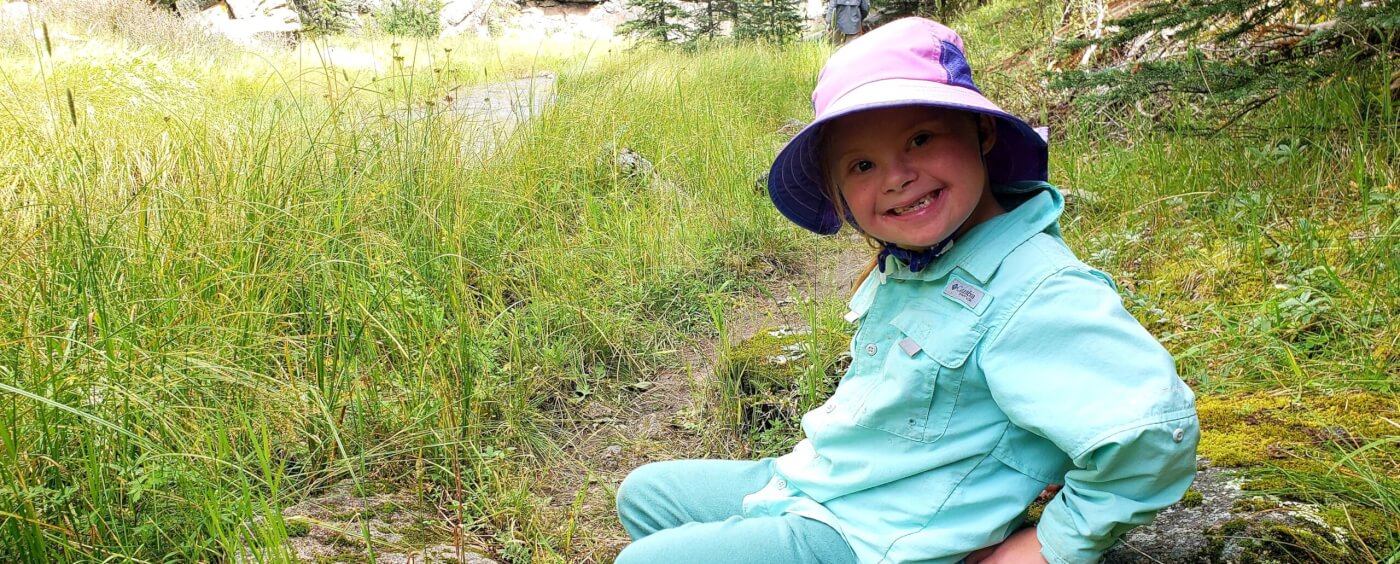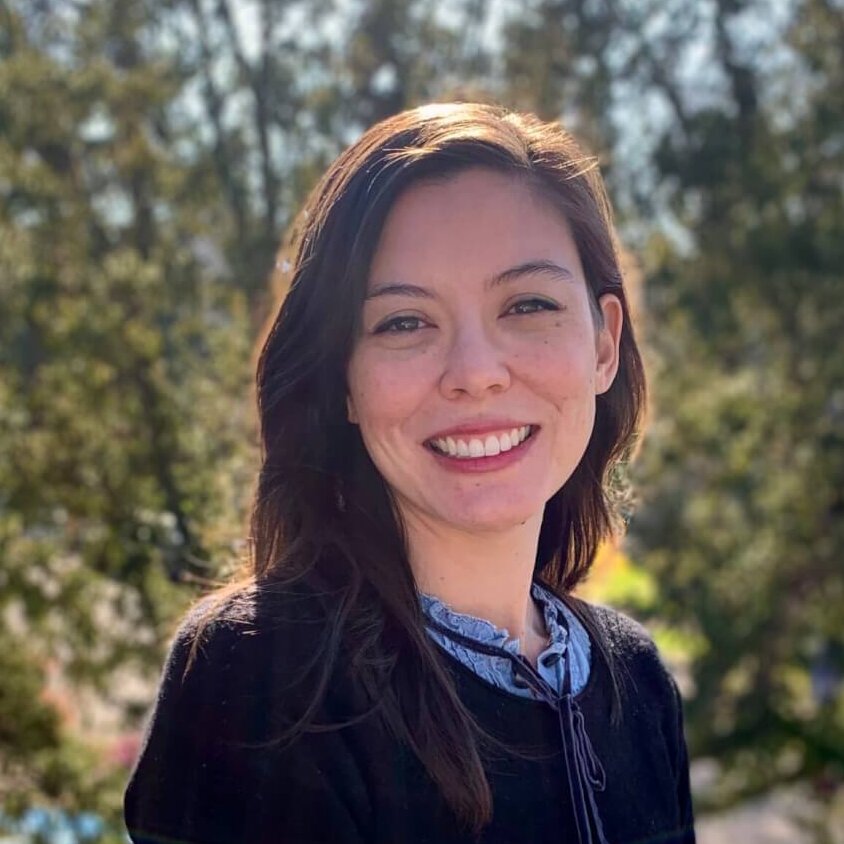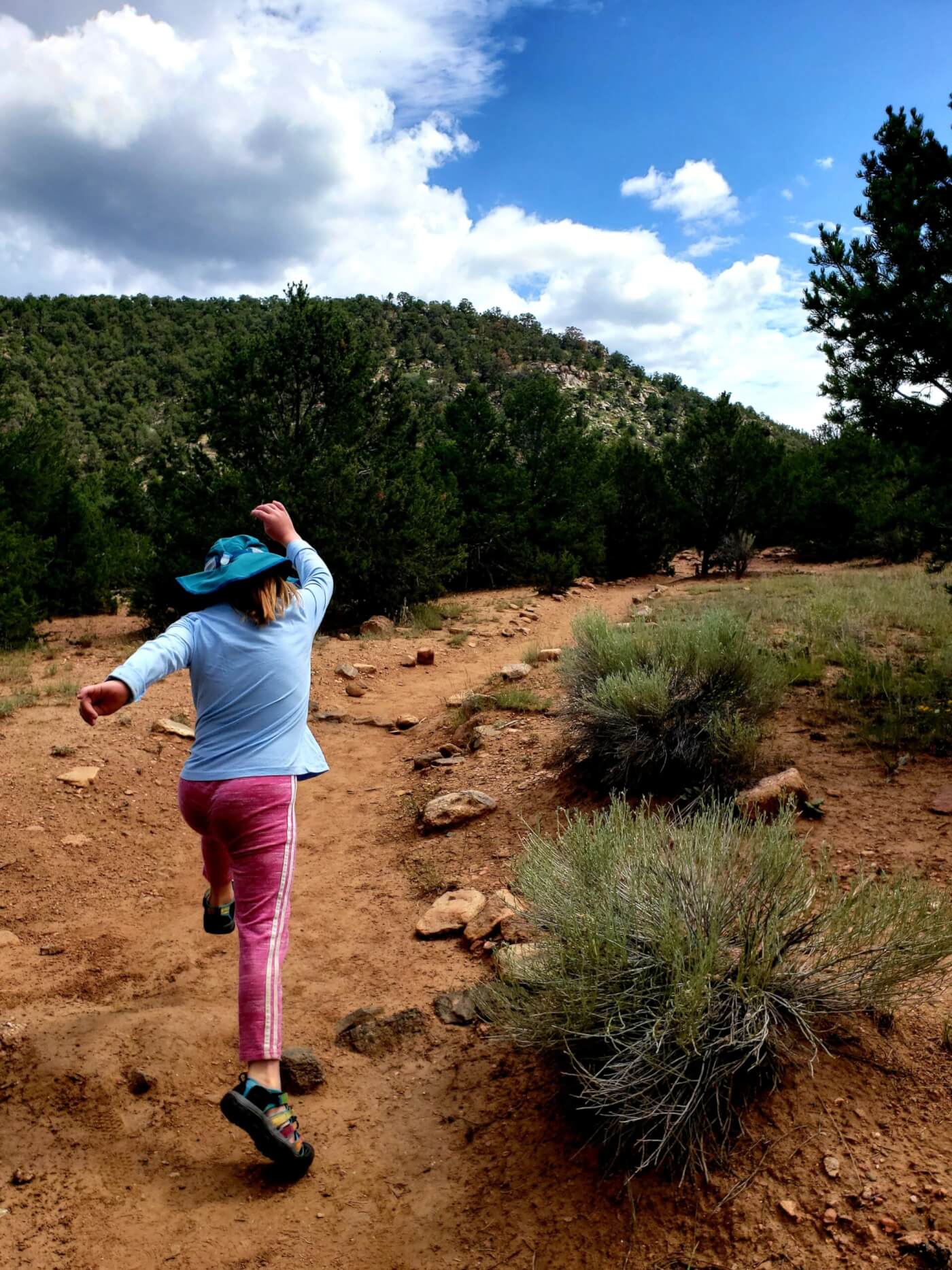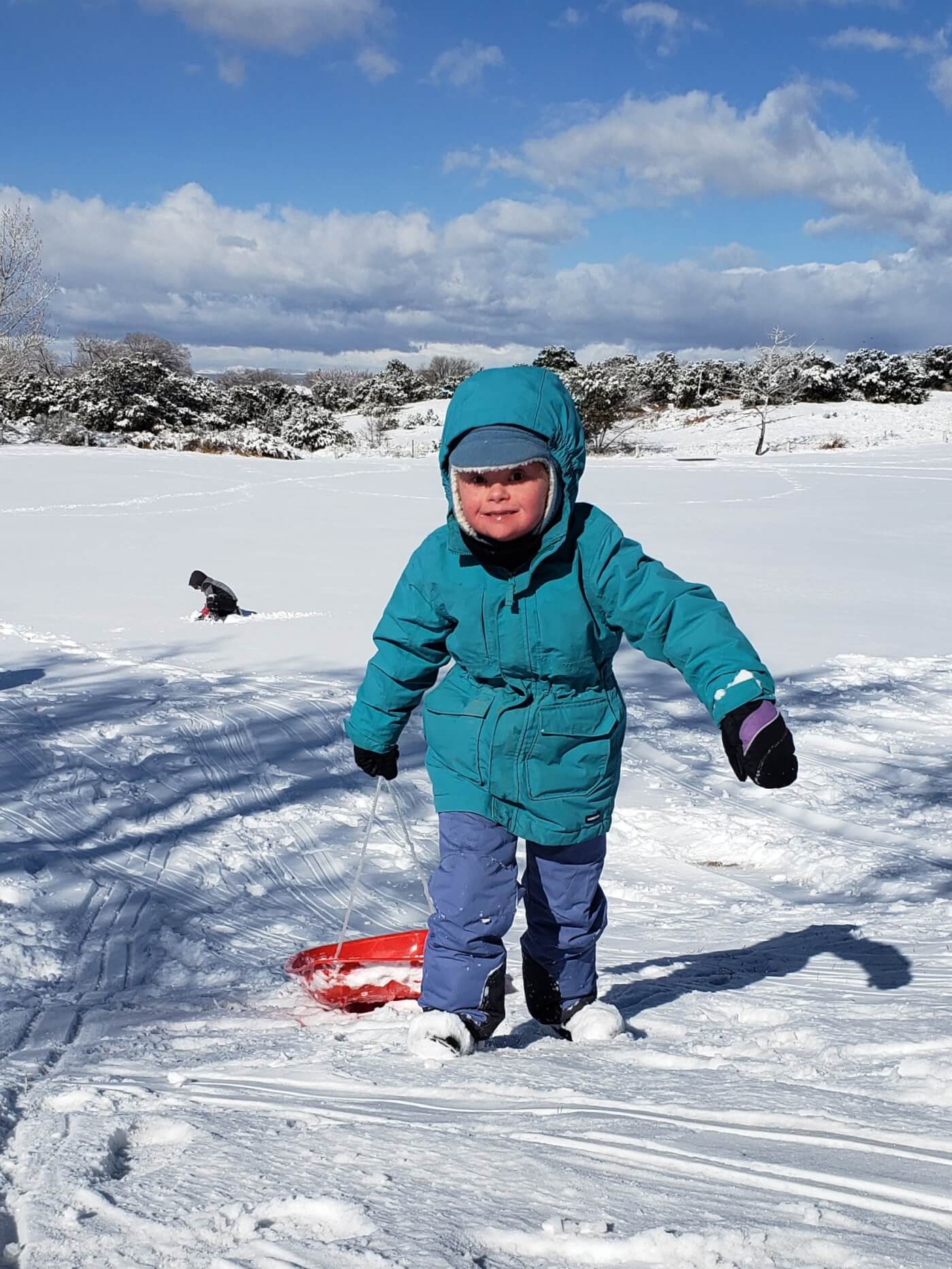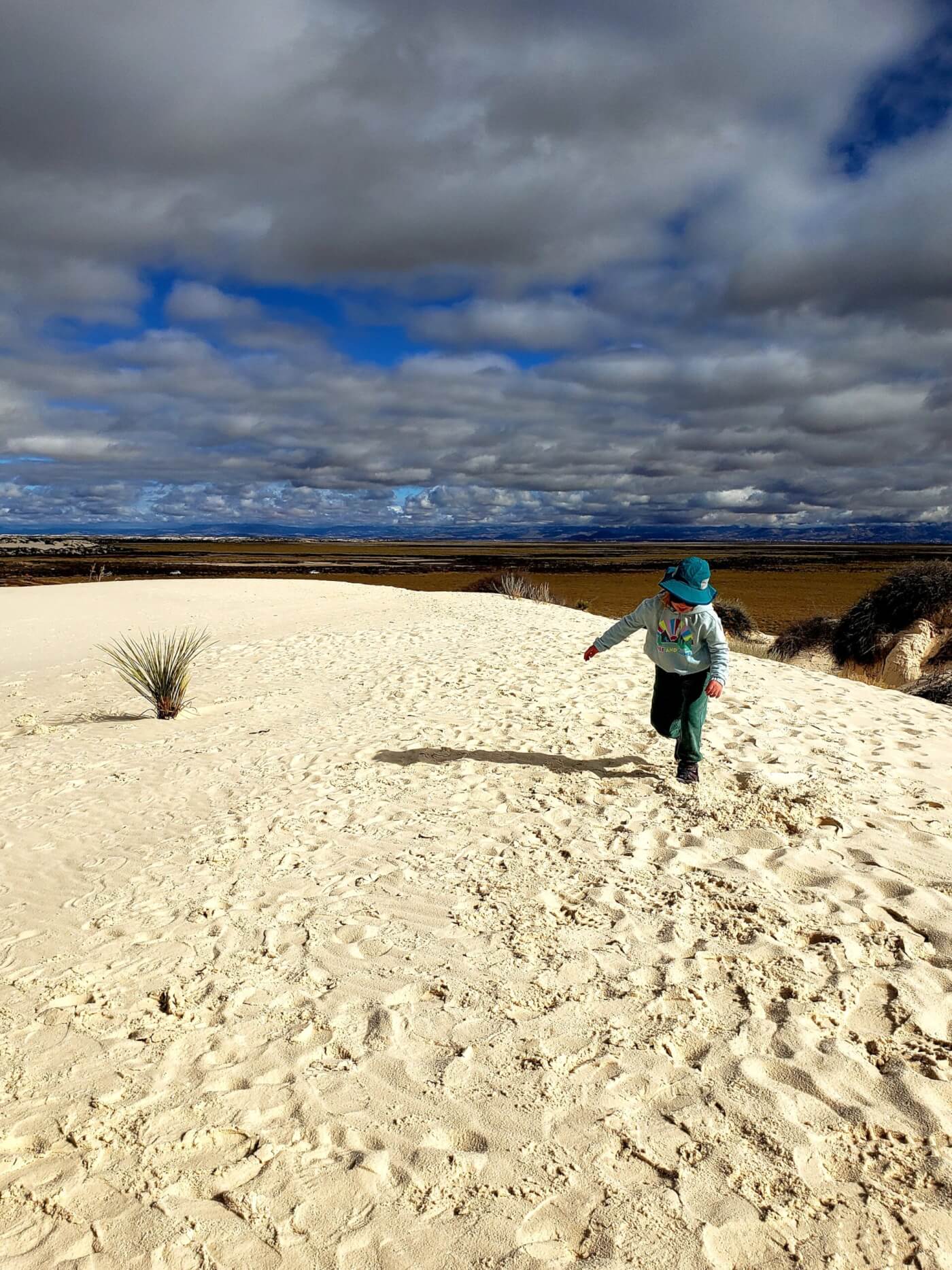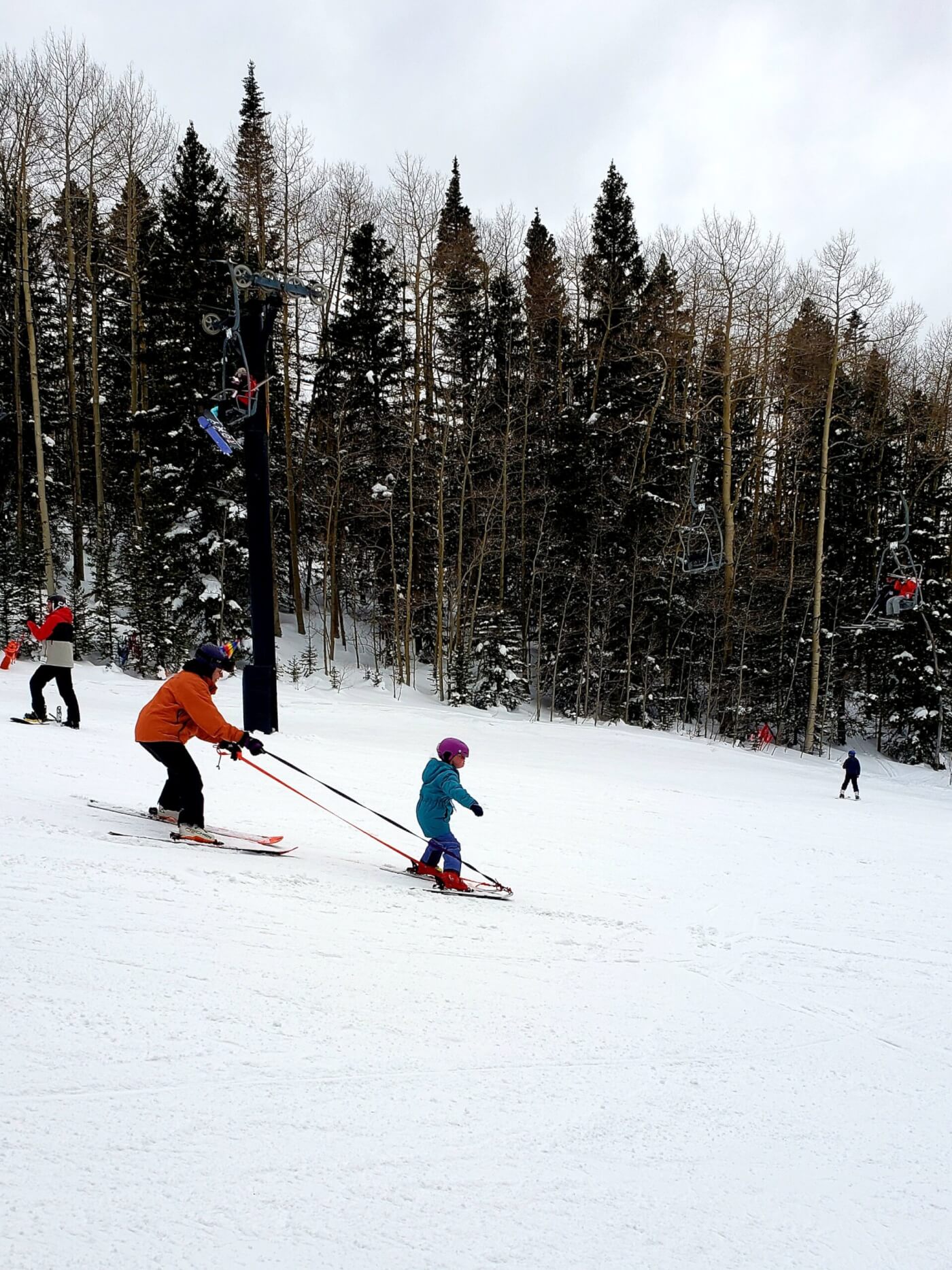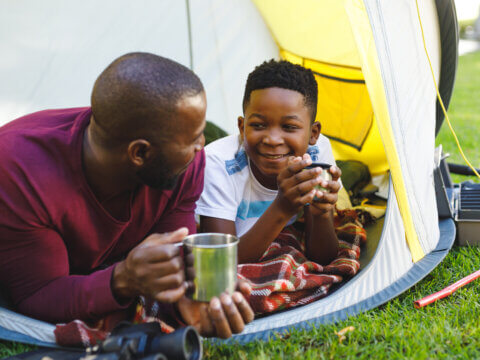“Naturally Inclusive” outdoor experiences for children of all abilities
Editor’s note: We’re thrilled to share excerpts from the new book “Naturally Inclusive: Engaging Children of All Abilities Outdoors,” authored by our Research Library curator Ruth Wilson. Excerpts are reprinted with permission from Gryphon House, Inc. You can find more resources in our “Connecting Children of All Abilities to Nature Play & Therapeutic Gardens” toolkit.
Awestruck: One child’s nature connection
Allyson, Leela’s mother, has seen firsthand how nature-related experiences in her daughter’s early childhood years have fostered Leela’s connectedness to nature and have had a healing effect.
Leela was born with Down syndrome and, from birth, had some hearing and vision challenges. She had open-heart surgery when she was two months old to patch congenital defects. She has chronic kidney disease, hypothyroidism, and partial agenesis (failure of all or a part of an organ to form or develop) of the corpus callosum, which connects the two hemispheres of the brain. Leela is now five years old and doing well as a kindergartener at the New Mexico School for the Deaf (NMSD).
A unique aspect of the NMSD program is a Forest Day Learning (FDL) experience. Leela has been a part of this program since she was three years old. Allyson has seen ways in which the nature-rich experiences have been good for Leela — nature is a teacher, therapist, and source of joy for her.
While time in nature has helped Leela learn about her physical self, it has also helped her learn about her spirit, her soul. Allyson notices how Leela readily taps into the changes of the seasons and the movements of the wind. “Nature, for Leela,” she says, “is a living organism, a place of shared relationship.” Allyson describes Leela’s experience as “being with nature versus doing something in or to nature… Leela seems to have a sense of belonging in nature. It has a calming effect on her.” Allyson describes how the sensory elements of nature can, at times, allow for a sensory reset. “Tantrums end when we take Leela outside. It’s a healing-in-the-moment experience.” According to Allyson, Leela’s experiences with nature have elevated her sense of self, allowing her to see herself as a part of something larger.
– “Naturally Inclusive: Engaging Children of All Abilities Outdoors,” by Ruth Wilson, pp 70-72
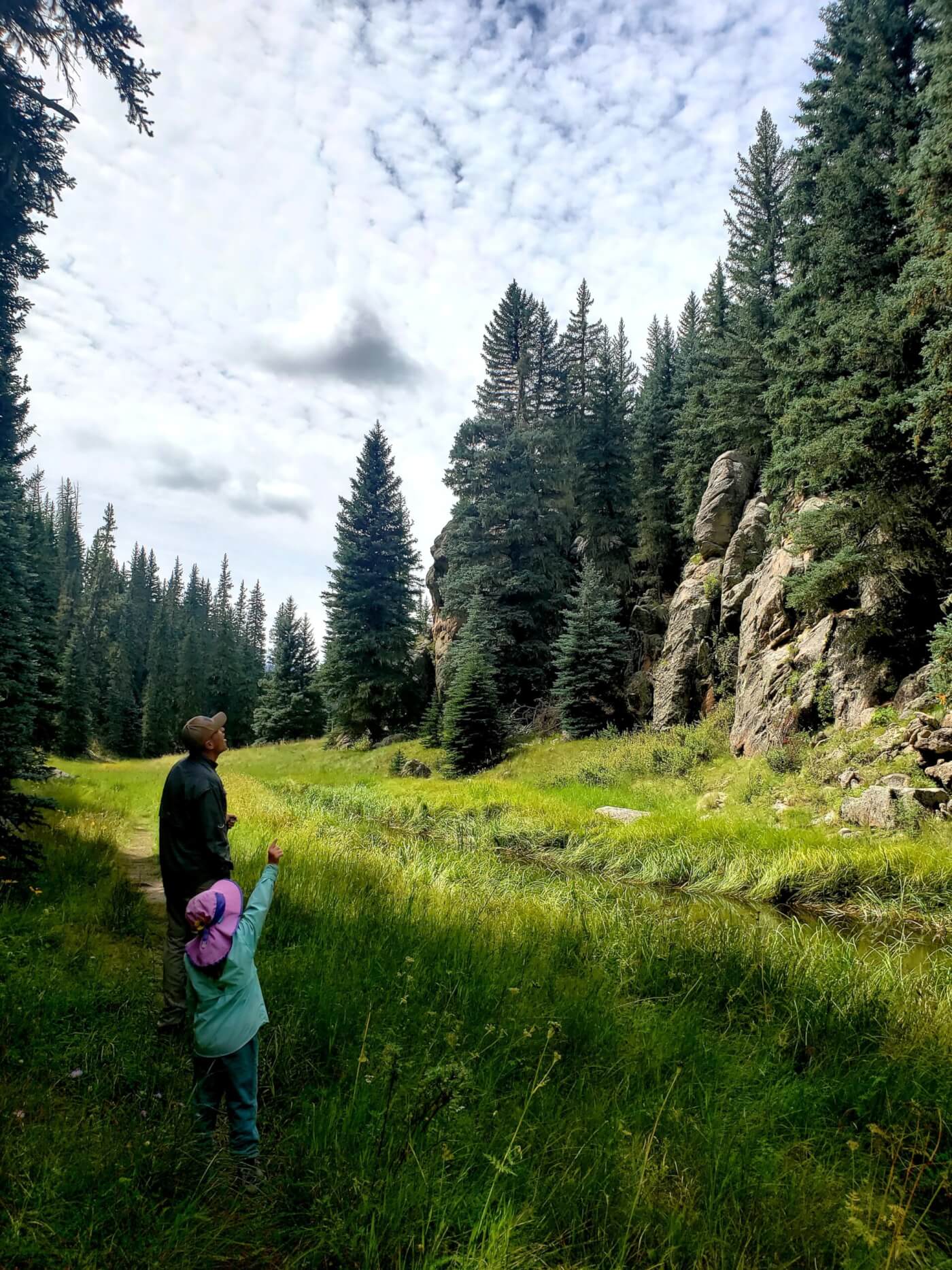
Leela explores Valles Caldera in New Mexico with her father.
This excerpt from the book “Naturally Inclusive” illustrates the ways that time in the outdoors can be crucial for children with special needs. Today eight years old, Leela’s physical abilities and confidence have come even farther in the years since Leela’s mother Allyson Rhatigan described them to Ruth for her book.
“I call it functional PT [physical therapy],” Allyson explains. “You can do PT in the gym all day, but when you’re on trails with uneven surface, crossing water — it is all full body with a purpose and a function. She has developed incredible balance and coordination with all this.”
Staying active is not just a nice-to-have for Leela — her congenital heart defects mean that regular physical exercise is essential for her current and long-term heart health. “Hiking can be her medicine,” Allyson says.
There are other benefits to time in nature, as well. “All kids need to be outside,” Allyson says, “but specifically for our daughter, there’s a natural and immediate emotional regulation that happens when she’s outside.”
Allyson believes that Leela and other children with special needs often feel more at ease in the outdoors than in daily life. “There’s no need to explain yourself. You can just be who you are.”
“Spoken language can sometimes get in the way of Leela expressing herself,” Allyson says. “In nature, so much unspoken communication is happening when you commune with plants and animals.”
Leela often has an emotional, visceral response to her time in nature. At their first family vacation in Yosemite, California, Leela was so awestruck by the towering redwoods that she couldn’t tear her eyes away. “She was looking straight up, having hazards and trips,” Allyson says. But even on ordinary family hikes or park visits, Leela will often put her hands on her heart in awe, exclaiming, “The beauty! The trees! And the wind! And the birds!”
“For our family, that shared joy is very healing,” Allyson says.
Challenge by choice: A nature connection program for all children
In 2002, my husband and I accepted two siblings as a foster-care placement in our home; we adopted them in 2006. We were camping with some friends when we noted how our son, who usually had difficulty connecting with others because of his autism and intellectual disability, was playing at a stream with other children. As the children were catching frogs, our son was in on the action, communicating and having less conflict than usual. We wondered whether there was a connection between nature experiences and improved language and social skills in children with autism. We discovered — with the help of Richard Louv’s book, Last Child in the Woods — that the children did better emotionally and socially when they were outside or connecting with animals.
A few years later, we decided to start a farm for children with special needs. Turn Back Time is a fifty-eight-acre property that features a working farm, a nature playground, an active beaver pond, and an extensive trail system. We offer a summer camp that serves more than six hundred children of all abilities per year. The mission of Turn Back Time includes helping people recognize nature’s ability to teach and heal. The farm is a great equalizer, because in nature children are not constrained by any diagnosis, disorder, shape, size, or age. The programming includes nature exploration, farm education, and play.
At Turn Back Time, everyone is a rock star, and staff work hard to find each child’s competency. A “challenge by choice” philosophy helps each child find his or her place at the farm and allows personal growth and resiliency through experiences. We believe — and research confirms — that play and nature are essential to every child’s development. It’s through play and nature that children learn to navigate the world around them.
*Contributed by Lisa Burris, co-founder and executive director of Turn Back Time, a nonprofit farm and nature-based program in Paxton, Massachusetts
– “Naturally Inclusive: Engaging Children of All Abilities Outdoors,” by Ruth Wilson, p 44
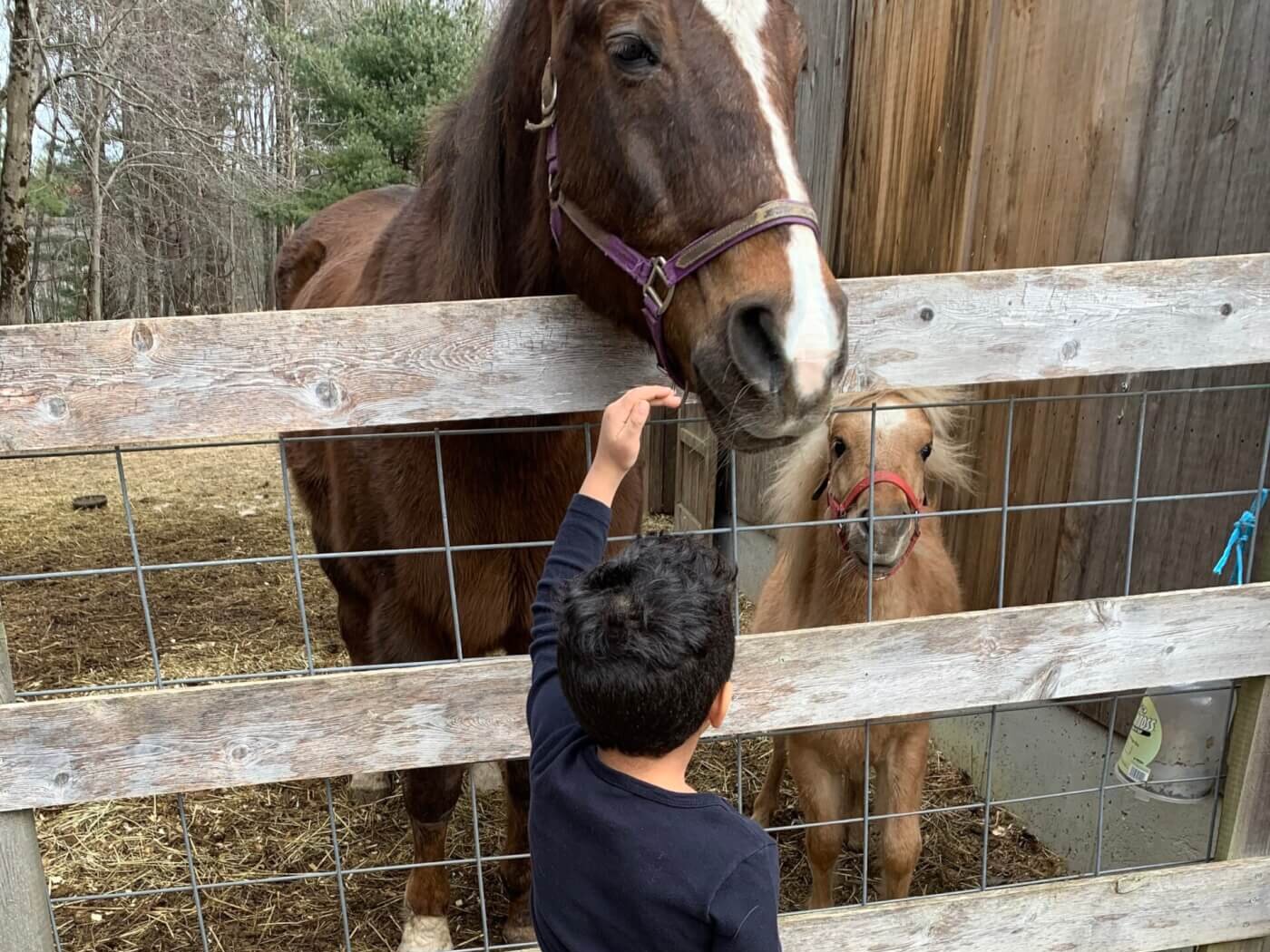
At Turn Back Time, taking care of animals is an important job for even the youngest participants!
After more than a decade of leading children’s nature programs at Turn Back Time, Lisa Burris can’t say enough about the ways that nature can support and empower children of all ages and abilities. “Nature is the great equalizer,” Lisa explains.
Lisa sees two different ways that children often find success at Turn Back Time. The first type of child might be a little bit uncomfortable in the outdoors, perhaps experiencing fear or sensory overload. For these children, the “rock star moment” comes from building resilience. “They might say, ‘I’m really brave because I was afraid of that chicken, and now I can hold the chicken!’” Lisa says.
The second type of child needs what Lisa describes as “big body play.” “This is the child who can run really fast and climb really high, and isn’t afraid of anything,” Lisa says. These children are often high energy and have been told that they’re too much by educators and caregivers. They may have ADHD, or may just have extra energy that they need to expend throughout the day.
Lisa has seen major shifts in behavior by children who were “difficult” at other programs. “They needed to get their energy out,” she explains. Once these children are given proper outlets to run, play and explore, they are better able to pay attention and control their bodies when appropriate, even gently handling fragile baby animals on the farm. The children also have fewer outbursts at home because they’re not feeling so pent up and frustrated. “Mothers have told me, ‘I feel like I have my child back,’” Lisa says.
Ultimately, Lisa feels that it’s not a question of if, but how to include children of all abilities in nature programs. “It can feel scary — what if a child runs away or hurts themselves?” Lisa asks. “But I don’t feel like it’s a choice. I think we have to figure it out.”
Nature fascination: An expert’s perspective
Before she grew up to be an educational consultant, curriculum writer and Children & Nature Network Research Library curator, author Ruth Wilson was just a girl on a farm. “I was around plants and animals on a daily basis,” Ruth explains. “I knew the fascination of planting a garden and seeing it grow.”
For Ruth, that fascination planted a seed that she drew upon years later, when working as an early childhood special educator. A lightbulb went off when she realized that nature-based programming would be a perfect fit for the children she worked with.
“They needed more hands-on curriculum, and more motivating activities. The programs needed to be meaningful to keep them engaged,” Ruth says.
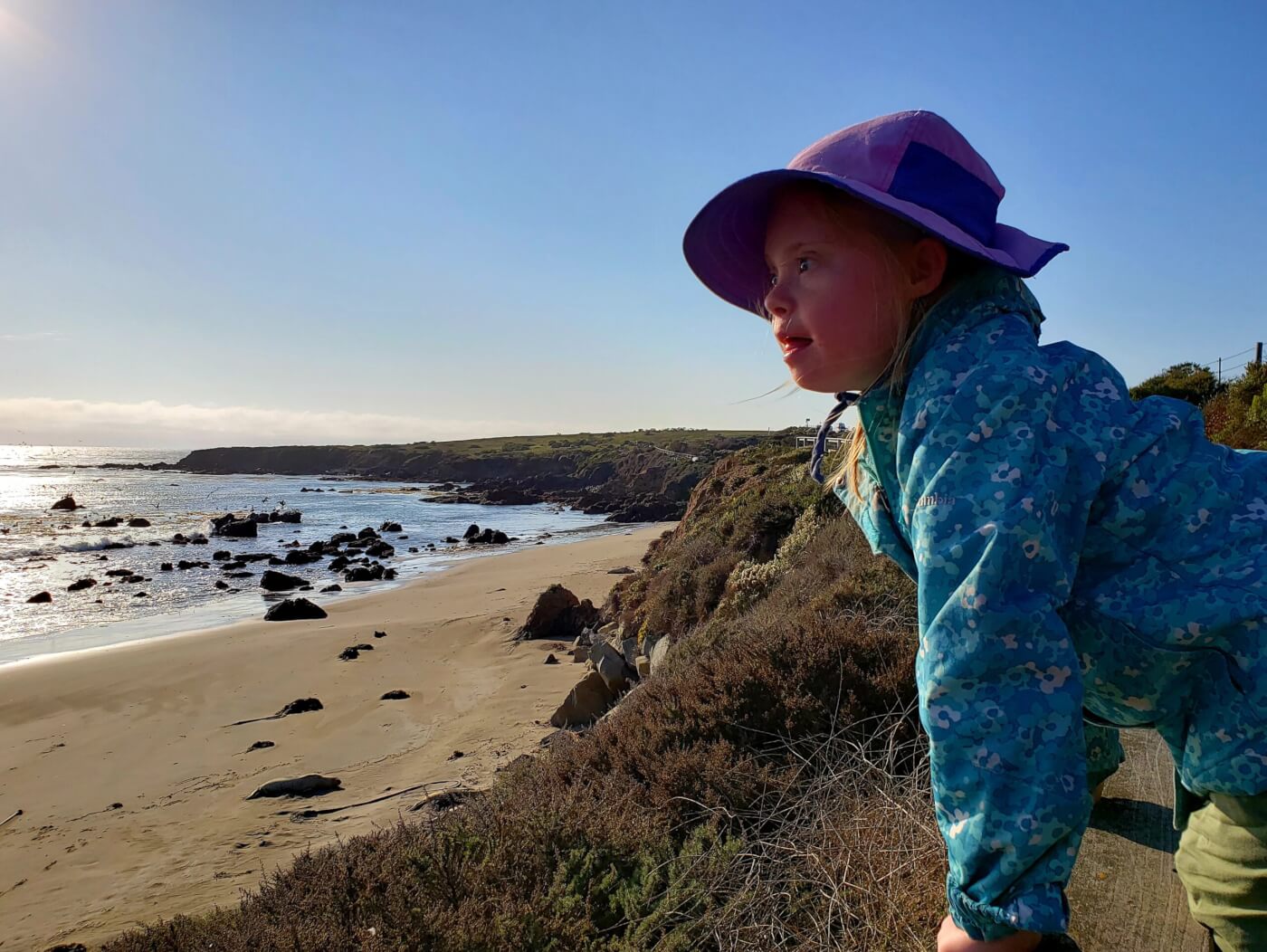
Leela gazes in wonder at the ocean.
Following a long career as an educator, Ruth decided to write “Naturally Inclusive” after identifying a persistent gap in resources on the topic and seeing strong interest from teachers, parents and environmental educators. During the process of researching and writing the book, she learned a lot about the unique benefits that nature connection can offer children with special needs.
“Nature doesn’t make judgments about the child,” she says. She notes that many children who feel different from others in social situations find solace in nature. “It gives them some down time — kids with special needs may need that more than other children.”
During her childhood on the farm, Ruth had a brother with special needs. “He never did well in school,” she says. “But he could have success in the garden, in the fields, working with animals… then he would have that sense of accomplishment.” Today, she sees a link between seeing him flourish on the farm when she was a young girl, and the work that she does today.
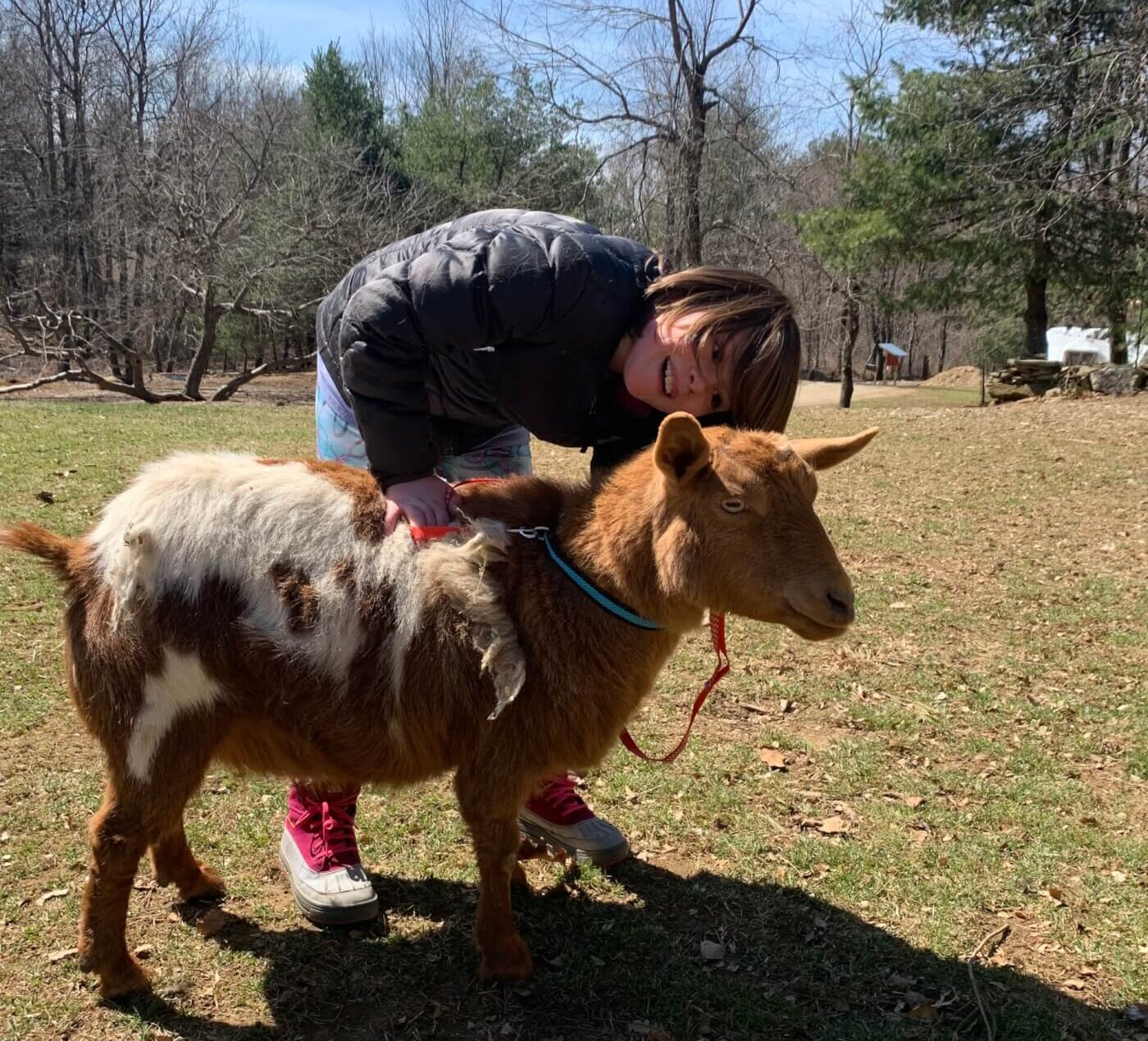
At Turn Back Time, children learn responsibility and compassion by connecting with animals.
In interviewing experts for “Naturally Inclusive,” Ruth was also struck by the natural empathy that children exhibit when they interact with animals. She tells the story of a chick with a crooked beak that hatched in a classroom. “The whole class was so concerned that the chick be taken care of,” Ruth explains. “A sense of caring was pulled out of the children due to the chick’s special needs.”
She emphasizes the strong connection to nature that children with special needs often feel — a connection that holds true of children of all abilities. “That’s the thing about nature — it is so real for the kids… and us,” Ruth muses. “Rain falls on every child.”
Practical tips for caregivers and practitioners
Allyson, Lisa and Ruth offered some words of wisdom for caregivers and practitioners interested in connecting children of all abilities to nature.
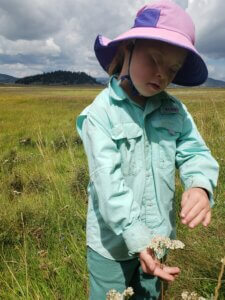
A quiet moment for Leela as she communes with wildflowers in New Mexico.
Allyson:
- You just gotta go for it. Go out your backdoor. Go to a park. Go out on your front stoop. Don’t think you need a huge plan, or mountain trail to explore, or elaborate camping trip.
- For families that might have extra considerations with mobility or gear, [going outside] could maybe be overwhelming. Just sitting outside, wheeling your kid outside, to watch the wind blow is enough.
- I encourage people to get outside in all weather. You learn a lot about yourself and the world by watching it change throughout the seasons. There’s a connection to something bigger when you spend time all year outside.
- Never underestimate your kid or your family… Leela blows us away. She rises to the occasion and exceeds expectations.
Lisa:
- Most behavior issues come from a lack of skill or an unmet need. Collaborative problem-solving can teach a skill through repetition. The hope then, is that the skill can transfer to other environments.
- Rituals and routines help children to stay engaged and connected. Our three pillars are safety, respect and responsibility.
- For many neurodivergent children, often they struggle with the rigidity of the program or environment that they’re in, so we try to be really flexible. We let them decide how they are going to interact with the space. Try to find an environment where you can give the child as many choices as possible.
- The #1 way to have success is low ratios and increased supervision. It just doesn’t work with one teacher for every 10 children.
- Whenever possible, create a yes culture so that children understand the “no” should be respected. Be open to what your child wants to do, and try not to have your own adult agenda.
Ruth:
- Let children be in an environment where nature is rich, where all of the senses can be engaged. Engage the senses of smell, taste and hearing.
Material from “Naturally Inclusive: Engaging Children of All Abilities Outdoors” by Ruth Wilson, PhD, ISBN 9780876599228 (pages 44, 70-72) is used with permission from Gryphon House, Inc., P. O. Box 10, Lewisville, NC 27023 (800) 638-0928 www.gryphonhouse.com.
Toolkit: Connecting Children of All Abilities to Nature Play & Therapeutic Gardens
Finding Nature News feature: Neurodiversity in nature: Occupational therapy in the outdoors helps children find confidence
Research Digest: Children with Special Needs
Learn more about the book “Naturally Inclusive: Engaging Children of All Abilities Outdoors,” by Ruth Wilson
See more of Ruth Wilson’s work in our Research Library, with extensive summaries of all the recent scientific literature about children and nature
-
Network News
POLICY UPDATE: Policy and advocacy for the children and nature movement
-
Voices
Binoculars, bald eagles and my journey as a Black birder
-
Richard Louv
THE WONDER BOWL: Ten Spring and Summer Nature Activities for Kids and Adults
-
Network News
Minneapolis Spotlight: The promise and possibilities of parks for youth
-
Voices
Why nature is my motherhood ally


